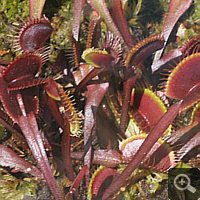Venus Flytrap (Dionaea muscipula)
Overview
The genus Dionaea ist monotypic, i.e. the genus consists of only one species, namely Dionaea muscipula. Dionaea muscipula is apart from Aldrovanda vesiculosa (Water Wheel Plant) the only plant with snap traps. The leaf end consits of two, circa each three centimetres long halves, which have each three feeling bristles. Is a feeling bristle stimulated within 20 seconds twice, so both leaf halves fold up under optimal conditions within 0.05 seconds and catch thus the prey. The following digestive process takes several days. In summer it produces numerous, circa one centimetre in diameter, white flowers. It originates in the east of the USA (North and South Carolina) and is partly hardy.
Trap mechanism
The trap mechanism was already detailed described on the previous site.
Culture and propagation
Culture and propagation of Dionaea muscipula are relative easy. Also beginners have mostly no problems with this species. As soil is unfertilized peat advisable, watered is in ebb and flood irrigation system (water level permanent one – two centimetres). A light location pleases the plant. An all-year culture on the windowsill is possible, however, in winter should the plant be offered a cooler location. Optimal is an all-year culture outdoor (bog bed, pondside) with frost protection in winter (leaves cover).
The Venus Flytrap is well to propagate both generative and vegetative. Seeds are relatively easy gathered. Sow these as light-dependent germinators on the soil and keep the peat henceforth permanent moist. At a light and warm location germination sets in quickly. But it takes years until the seedling is grown up to a flowering-sized plant.
Very old plants produce out from the underground rhizome several vegetation centres. The plants can be divided carefully. In addition, the Venus Flytrap is suitable to propagate by cuttings. For propagation by cuttings pluck carefully a leaf complete with the white leafstalk from the rhizome. Then give the leaf slight oblique into moist peat. At a humid, warm and light, but protected against direct sun light, location a small plant appears after some weeks.

